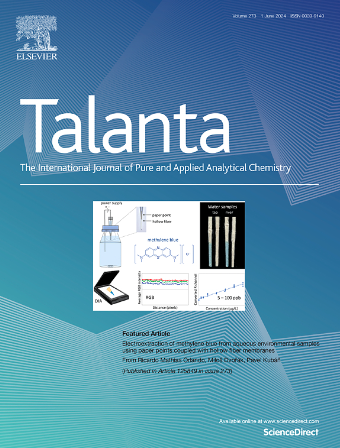A rapid and specific fluorescent probe based on ESIPT-AIE-active for copper ion quantitative detection in food and environmental samples
IF 5.6
1区 化学
Q1 CHEMISTRY, ANALYTICAL
引用次数: 0
Abstract
In the field of food safety, the identification and measurement of active components in food is a pressing issue. The concentration of copper ions (Cu2+) in the environment is closely linked to food safety, and overall biological health. Therefore, developing rapid and accurate analytical techniques to monitor Cu2+ in food is of great significance. In this study, two fluorescent probes L-2 and L-3 were synthesized through a simple Schiff base condensation reaction. And L-3 demonstrated better anti-interference ability to Cu2+ than that of L-2. Meanwhile, spectroscopic experiments showed that L-3 possessed an extremely low detection limit (LOD) and low limits of quantification (LOQ) (LOD = 92.79 nM, LOQ = 309.33 nM), and quickly respond time (<30 s). Probe L-3 for monitoring effectively quantitatively identified Cu2+ in food and environmental samples, achieving an accuracy rate ranging from 84.42% to 117.45% and precision with a relative standard deviation (RSD) of less than 6.0%. The accuracy had been validated using the inductively coupled plasma-mass spectrometry (ICP-MS). Simultaneously, a WeChat Mini Program has been developed to detect total copper content in food samples based on fluorescence values, enabling consumers to evaluate food safety more intuitively. Moreover, L-3 also facilitated the quantitative visualization of Cu2+ in biological systems, underscoring its compatibility and practicality.

基于esipt - aie活性的快速特异性荧光探针用于食品和环境样品中铜离子的定量检测
在食品安全领域,食品中有效成分的鉴定与测定是一个亟待解决的问题。环境中铜离子(Cu2+)的浓度与食品安全和整体生物健康密切相关。因此,开发快速、准确的食品中Cu2+的分析技术具有重要意义。本研究通过简单的希夫碱缩合反应合成了两个荧光探针L-2和L-3。L-3对Cu2+的抗干扰能力优于L-2。同时,光谱实验表明,L-3具有极低的检出限(LOD)和极低的定量限(LOQ) (LOD = 92.79 nM, LOQ = 309.33 nM)和快速的响应时间(<30 s)。用于监测的探针L-3可有效定量鉴定食品和环境样品中的Cu2+,准确度为84.42% ~ 117.45%,精密度相对标准偏差(RSD)小于6.0%。采用电感耦合等离子体质谱(ICP-MS)验证了该方法的准确性。同时开发微信小程序,根据荧光值检测食品样品中总铜含量,让消费者更直观地评价食品安全。此外,L-3还有助于生物系统中Cu2+的定量可视化,突出了其相容性和实用性。
本文章由计算机程序翻译,如有差异,请以英文原文为准。
求助全文
约1分钟内获得全文
求助全文
来源期刊

Talanta
化学-分析化学
CiteScore
12.30
自引率
4.90%
发文量
861
审稿时长
29 days
期刊介绍:
Talanta provides a forum for the publication of original research papers, short communications, and critical reviews in all branches of pure and applied analytical chemistry. Papers are evaluated based on established guidelines, including the fundamental nature of the study, scientific novelty, substantial improvement or advantage over existing technology or methods, and demonstrated analytical applicability. Original research papers on fundamental studies, and on novel sensor and instrumentation developments, are encouraged. Novel or improved applications in areas such as clinical and biological chemistry, environmental analysis, geochemistry, materials science and engineering, and analytical platforms for omics development are welcome.
Analytical performance of methods should be determined, including interference and matrix effects, and methods should be validated by comparison with a standard method, or analysis of a certified reference material. Simple spiking recoveries may not be sufficient. The developed method should especially comprise information on selectivity, sensitivity, detection limits, accuracy, and reliability. However, applying official validation or robustness studies to a routine method or technique does not necessarily constitute novelty. Proper statistical treatment of the data should be provided. Relevant literature should be cited, including related publications by the authors, and authors should discuss how their proposed methodology compares with previously reported methods.
 求助内容:
求助内容: 应助结果提醒方式:
应助结果提醒方式:


